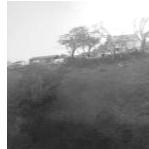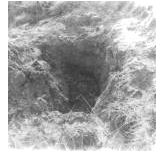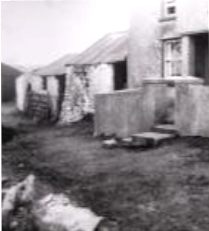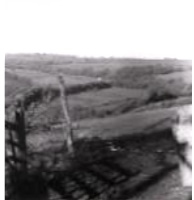In the years after WW2, an infamous murder occurred in West Wales. This murder actually took place in Rosemarket, at a small farm named Lower Furze Hill, several hundred yards to the north of the village off the Bastleford Road. This incident became widely known as The Claypit Murder and was reported in local and national media extensively.
The full details of the case are as follows.
The victim was Mr William Llewellyn, a retired farmer, who lived with his family at Ellesmere House, a large property at the top of Front Street in the village. He still then owned farmland and property to the north of the village, off the Bastleford Road, known as Lower Furze Hill Farm. The farm was at this time rented to Mr Albert Jenkins and his family and had been for a few years prior.
On the morning of 10th October 1949, Mr Llewellyn cycled from his home to meet Mr Jenkins at Lower Furze Hill Farm to discuss the rent arrears which had accrued and Mr Jenkins’ desire to purchase the farm. This meeting had been especially requested by Mr Jenkins, who later claimed he had handed Mr Llewellyn £1,050 that morning, this being £50 for the rent and £1,000 to purchase the farm outright on that date.
Mr Llewellyn never returned home for his midday lunch. Later that afternoon, Mrs Llewellyn sent their adult daughter to the farm to look for him. Upon her arrival, she was told by Mr Jenkins that her father had left the farm after a very short meeting there. A further visit to the farm in the afternoon found no one at home and with her husband still missing, Mrs Llewellyn informed the police.
Searching for Mr Llewellyn
Police investigations and enquires began and word soon spread around the village of Mr Llewellyn’s disappearance. Some village volunteers set out across the fields and woodland in the area to try and find Mr Llewellyn.
By early evening, with the property at Lower Furze Hill Farm still empty, it had been established that Mr Jenkins had gone to Pembroke to meet with his family who had left early that morning to attend the annual Pembroke Fair, which was always held in that early-October period. Police met Mr Jenkins and his family walking back to the village from nearby Neyland that night.
Mr Jenkins told the police that he had only seen Mr Llewellyn briefly that morning. He explained the purpose of their discussions and that he had finalised the purchase of the farm with Mr Llewellyn and paid him cash for the purchase and the outstanding rent that had been owed. He said that after this meeting, Mr Llewellyn had promptly left the farm and he had not seen him since.
During the evening, further searches of the area continued with police also seeking any witnesses who had seen Mr Llewellyn at any time during the day. Several people claimed to have seen Mr Llewellyn on his bicycle on the Bastleford Road that same morning. However, no one claimed to have seen Mr Llewellyn in the afternoon or later that day.
Discovery of the body
The search for Mr Llewellyn continued the next day and at about 4pm of October 11th, down in the clay field on the farm, some freshly dug and loosely laid earth was noticed by the police search team. A walking stick put into this earth found that the soil offered little or no resistance – the stick went in a couple of feet. The soil was removed by the police with local volunteers assisting. Sadly, the body of a man wrapped in a tarpaulin sheet and bound with rope was discovered, later identified as being that of Mr Llewellyn.




Mr Jenkins accompanied the police to the site, at their request, when the body was being raised from the hole at about 7pm. When the body was bought to the surface, Mr Jenkins was heard to say that the tarpaulin sheet belonged to him. At this time, he was then taken to Milford Haven police station and detained for further enquires.
Police records show the following was discovered:
- Mr Llewellyn’s body was fully clothed apart from his boots and socks. His cap was also missing. His boots were subsequently found in a barn on the farm, under a pile of manure. Furthermore, the boots didn’t have any laces with them. The laces were later found in Mr Jenkins’ pocket when he was searched at the police station.
- Mr Llewellyn’s autopsy revealed he had been bludgeoned to the head. No murder weapon was ever found.
- The clothing Mr Jenkins was wearing was submitted for examination and traces of human blood were discovered on the corduroy trousers he was wearing.
- A witness reported seeing Mr Jenkins on his tractor at his farm at 11.30am on the day Mr Llewellyn disappeared. This was Mr Codd, an employee of the agricultural committee who had called to the farm following an earlier request to attend to a cow on the farm. Mr Codd reported that he had seen Mr Jenkins driving his tractor very quickly towards the clay field with a large bundle on the rear of the vehicle. Mr Codd also commented that on his previous visits to the farm, Mr Jenkins had always accompanied him to the cattle but on this occasion ignored him completely.
- At 2.30pm on the day Mr Llewellyn disappeared, Mr Jenkins was seen by a witness in the vicinity of the clay field. He was seen “walking very quickly and carrying a long handed shovel and something which looked like a spade”.
- Mr Jenkins went to meet his wife and family at the Pembroke Fair as had been planned on the day of Mr Llewellyn’s disappearance (his family having left the farm around 9am). He said he had walked through Rosemarket and down to catch the ferry boat at Neyland after leaving the farm to go to Pembroke. However, a witness came forward to say that he had seen Mr Jenkins cycling through Jordanston, near Rosemarket, that same afternoon. No one appears to have seen Mr Jenkins walking through Rosemarket. On this same evening, after 5pm, a Neyland resident, found a bicycle lying on the grass verge about 800 yards from the Neyland ferry. He did nothing about it that evening, but the following morning, seeing it in the same place, picked it up and placed it in the ruins of an old chapel nearby. This bicycle was later identified as being owned by Mr Llewellyn – the bicycle on which he had left his home to cycle to Lower Furze Hill Farm.
- No trace of the money that Mr Jenkins said he had paid Mr Llewellyn was ever found. Many people at the time questioned whether any money had ever existed.
Convicted of murder
Mr Jenkins was charged with the murder of Mr Llewellyn, remanded in Swansea prison and the trial took place at the Shire Hall in Haverfordwest in the Spring of 1950. The prosecution case was that Mr Llewellyn was murdered by Mr Jenkins. Whilst there was no eyewitness evidence of the act, the circumstantial evidence was substantial. After falsifying a receipt for the money it was claimed, Mr Jenkins bludgeoned Mr Llewellyn to death. He had then wrapped the body in tarpaulin and buried it in the clay pit on his farm.
Mr Jenkins was convicted of the murder of Mr Llewellyn and sentenced to death by hanging. The Jury took less than two hours to reach its verdict. When the guilty verdict was given, it was reported that Mr Jenkins “gazed intently at the Judge and remained remarkedly unmoved”.
An appeal against the sentence was lodged with the Home Secretary but refused and so at 9.25am on 19th April 1950, Albert Edward Jenkins was put to death at Swansea Gaol.
At the main gate of Swansea Gaol, two warders posted the declaration of his death and a crowd of around 35 people had gathered there. Mr Llewellyn’s executioner was the renowned Albert Pierrepoint, who executed hundreds of people in his 25-year career.
Mr Jenkins was the first person from Pembrokeshire to be executed for over 100 years.
Laid to rest
Mr Llewellyn’s funeral took place at Rosemarket Chapel, which was reportedly filled to capacity. The service was conducted by the Rev. R. Stokes (Congregational Minister of Rosemarket and Neyland Chapels) and assisted by the Rev. C.P. Willis (Vicar of Rosemarket).
One newspaper report of that day stood out in particular: …“If any reminder was needed of the occurrence which had shocked all, it was the presence of uniformed policemen, an unusual sight at a village funeral. These were the men who had assisted in the discovery of the untimely death of ‘the village market gardener’ – a terrible affair which had soon become worldwide news”.